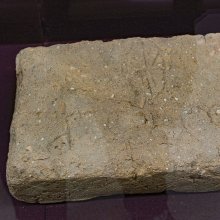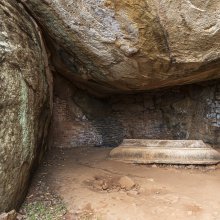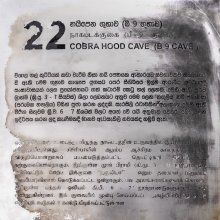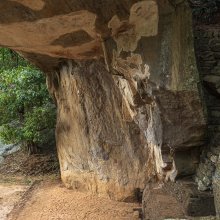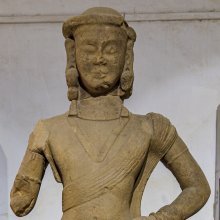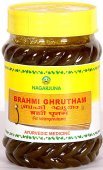Brahmi, Brāhmī: 42 definitions
Introduction:
Brahmi means something in Hinduism, Sanskrit, Jainism, Prakrit, the history of ancient India, Marathi, Hindi, biology. If you want to know the exact meaning, history, etymology or English translation of this term then check out the descriptions on this page. Add your comment or reference to a book if you want to contribute to this summary article.
Images (photo gallery)
(+2 more images available)
In Hinduism
Ayurveda (science of life)
Cikitsa (natural therapy and treatment for medical conditions)
Source: Wisdom Library: Ayurveda: Cikitsa1) Brāhmī (ब्राह्मी) is a Sanskrit word referring to the Bacopa monnieri (Indian pennywort), a perennial herb from the Plantaginaceae family, and is used throughout Ayurvedic literature such as the Caraka-saṃhitā. Other commonly used English names include “herb of grace” and “water hyssop”. It prefers marsy areas throughout India, Nepal and neighbouring regions.
This plant (Brāhmī) is also mentioned as a medicine used for the treatment of all major fevers, as described in the Jvaracikitsā (or “the treatment of fever”) which forms the first chapter of the Sanskrit work called Mādhavacikitsā.
2) Brāhmī (ब्राह्मी) is a Sanskrit word referring to Centella asiatica (centella), a perennial herb from the Apiaceae family, and is used throughout Ayurvedic literature such as the Caraka-saṃhitā. Other commonly used named in English include “gotu kola” and “Thunder god’s root”. It is native to wetlands in Asia and prefers tropical swampy areas.
Kalpa (Formulas, Drug prescriptions and other Medicinal preparations)
Source: Shodhganga: Edition translation and critical study of yogasarasamgrahaBrāhmī (ब्राह्मी) refers to the medicinal plant known as “Bacopa monnieri (Linn.) Pennel” and is dealt with in the 15th-century Yogasārasaṅgraha (Yogasara-saṅgraha) by Vāsudeva: an unpublished Keralite work representing an Ayurvedic compendium of medicinal recipes. The Yogasārasaṃgraha [mentioning brāhmī] deals with entire recipes in the route of administration, and thus deals with the knowledge of pharmacy (bhaiṣajya-kalpanā) which is a branch of pharmacology (dravyaguṇa).
Nighantu (Synonyms and Characteristics of Drugs and technical terms)
Source: WorldCat: Rāj nighaṇṭu1) Brāhmī (ब्राह्मी) is another name for Tejovatī, a medicinal plant similar to Jyotiṣmatī Celastrus paniculatus (black oil plant or intellect tree) from the Celastraceae or “staff vine” or “bittersweet family” of flowering plants, according to verse 3.82 of the 13th-century Raj Nighantu or Rājanighaṇṭu. The third chapter (guḍūcyādi-varga) of this book contains climbers and creepers (vīrudh). Together with the names Brāhmī and Tejovatī, there are a total of thirty-one Sanskrit synonyms identified for this plant. Note: Bāpālāl identifies Tejovatī with Zanthoxylum budrunga (cape yellowwood or Indian ivy-rue).
2) Brāhmī (ब्राह्मी) is also mentioned as a synonym for Ajagandhā, a medicinal plant, possibly identified with Gynandropsis gynendra Linn., a synonym of Cleome gynandra or “shona cabbage” from the Cleomaceae family of flowering plants, according to verse 4.177-178. The fourth chapter (śatāhvādi-varga) of this book enumerates eighty varieties of small plants (pṛthu-kṣupa). Together with the names Brāhmī and Ajagandhā, there are a total of eight Sanskrit synonyms identified for this plant.
3) Brāhmī (ब्राह्मी) is the Sanskrit name for a medicinal plant identified with two possibly species verse, according to verse 5.63-66. Note: Chopra identifies Brāhmī with 1) Centella asiatica (Linn.) Urban. while Bāpālāl and Th. B.S. et al identify it with 2) Bacopa monnieri (Linn.) Pennell.
Brāhmī is mentioned as having twenty-three synonyms: Sarasvatī, Saumyā, Suraśreṣṭhā, Suvarcalā, Kapotavegā, Vaidhātrī, Divyatejā, Mahauṣadhī, Svayambhuvī, Somalatā, Surejyā, Brahmakanyakā, Maṇḍūkamātā, Matsyākṣī, Maṇḍūkī, Surasā, Medhyā, Vīrā, Bhāratī, Varā, Parameṣṭhinī, Divyā and Śārdī.
Properties and characteristics: “Brāhmī is cooling (hima), astringent (kaṣāya) and bitter (tikta). It cures diseases due to vitiated vāta and bleeding disorders (raktapitta). It gives longevity and promotes intellect (buddhi), wisdom (prajñā) and mental power (medhā)”.
4) Brāhmī (ब्राह्मी) is another name for Matsyākṣī an unidentified medicinal plant, possibly identified with either (1) the Kannada synonym Hongonda—Alternanthera sessilis or (2) Enhydra fluctuans Lour., according to verse 5.127. The fifth chapter (parpaṭādi-varga) of this book enumerates sixty varieties of smaller plants (kṣudra-kṣupa). Together with the names Brāhmī and Matsyākṣī, there are a total of five Sanskrit synonyms identified for this plant.
Toxicology (Study and Treatment of poison)
Source: Shodhganga: Kasyapa Samhita—Text on Visha ChikitsaBrāhmī (ब्राह्मी) (juice) is the name of an ingredient used in the treatment of Maṇḍalī-snake-bites, according to the Kāśyapa Saṃhitā: an ancient Sanskrit text from the Pāñcarātra tradition dealing with both Tantra and Viṣacikitsā—an important topic from Āyurveda which deals with the study of Toxicology (Viṣavidyā or Sarpavidyā).—A number of different permutation and combination of herbs are prescribed as Lepa and Pāna for removing the poison of Maṇḍalī snakes.—According to the Kāśyapasaṃhitā verse 9.86: “Turmeric, Yaṣṭi, Triphalā (Harītakī, Vibhītaki and Āmalakī) in equal measure), mixed with milk of Snuhī and four products of cow along with Brāhmī juice and ghee is a potent queller of Maṇḍalī poison”.
Unclassified Ayurveda definitions
Source: PMC: Ayurvedic management of postlumbar myelomeningocele surgeryBrāhmī (Bacopa monieri): Considerable number of studies (animal experiments and clinical trials) have been done to evaluate its efficacy in learning and memory. It was concluded that Brāhmī has a positive effect on learning and both short-term and long-term memory. In a recent double-blind, placebo-controlled clinical trial, the above findings were further proved and it was found that maximal effect was evident after 12 weeks of treatment.
Source: PMC: Evaluation of Brāhmī ghṛtam in children suffering from Attention Deficit Hyperactivity DisorderA recently published systematic review on complementary and alternative medicines in ADHD has identified Bacopa monnieri (Brāhmī) as a potential agent for improving attentional and hyperkinetic disorders via a combination of cognitive enhancing and sedative effects. Although our study has demonstrated potential of Brāhmī ghṛtam in ADHD, we did not observe any sedative effect of Brāhmī; in fact the medication showed stimulant activity. This difference may be due to the presence of other plant ingredients and ghṛtam.
Source: Advances in Zoology and Botany: Ethnomedicinal List of Plants Treating Fever in Ahmednagar District of Maharashtra, IndiaBrāhmī in the Marathi language refers to the medicinal herb “Bacopa monnieri (L.) Pennel.”, and is used for ethnomedicine treatment of Fever in Ahmednagar district, India. The parts used are: “Leaves”. Instructions for using the herb named Brāhmī: A fresh leaf juice 10 ml (5 ml for children)—twice a day.

Āyurveda (आयुर्वेद, ayurveda) is a branch of Indian science dealing with medicine, herbalism, taxology, anatomy, surgery, alchemy and related topics. Traditional practice of Āyurveda in ancient India dates back to at least the first millenium BC. Literature is commonly written in Sanskrit using various poetic metres.
Shaktism (Shakta philosophy)
Source: Wisdom Library: Śāktism1) Brāhmī (ब्राह्मी, “The Śakti of Brāhma”):—One of the names of Mahāsarasvatī (sattva-form of Mahādevī). Mahālakṣmī is one of the three primary forms of Devī. Not to be confused with Lakṣmī, she is a more powerful cosmic aspect (vyaṣṭi) of Devi and represents the guṇa (universal energy) named sattva. Also see the Devī Māhātmya, a Sanskrit work from the 5th century, incorporated into the Mārkaṇḍeya-Purāṇa.
2) Brahmi (ब्रह्मि, “the power of the immense being”):—One of the names of Sarasvatī, the Hindu goddess of speech, eloquence and all forms of knowledge.
3) Brāhmī (ब्राह्मी):—Name of one of the sixty-four mātṛs to be worshipped during Āvaraṇapūjā (“Worship of the Circuit of Goddesses”, or “Durgā’s Retinue”), according to the Durgāpūjātattva. They should be worshipped with either the five upācāras or perfume and flowers.
Her mantra is as follows:
Source: Sreenivasarao's blog: Saptamatrka (part 4)ॐ ब्राह्म्यै नमः
oṃ brāhmyai namaḥ.
Brahmi or Brahmani refers to one of the seven mother-like goddesses (Matrika).—The Matrikas emerge as shaktis from out of the bodies of the gods: Brahmi form Brahma. The order of the Saptamatrka usually begins with Brahmi symbolizing creation. It is often represented by the all-comprehensive primordial Nada Om (pranava). The most important significance of Saptamatrka symbolism is the implication of the cyclical universal time and its cessation. In the standard versions, Brahmi symbolizes creation.
The Bhavanopanishad (9) recognizes Matrikas as eight types of un-favourable dispositions, such as: desire, anger, greed, delusion, pride, jealousy, demerit and merit. Tantra-raja-tantra (36; 15-16) expands on that and identifies Brahmi with desire (kama).
According to Khadgamala (vamachara) tradition of Sri Vidya, the eight Matrkas are located along the wall (four at the doors and four at the corners) guarding the city (Tripura) on all eight directions: Brahmi on the West.
Source: Kamakoti Mandali: The Yoginis of Narasimha VyuhaBrāhmī (ब्राह्मी) is the name of a Mātṛkā-Śakti created by Mahārudra in order to control the plague of demons created by Andhakāsura.—Accordingly, Andhaka-Asura tried to kidnap Umā (Devī Pārvatī), and was fiercely attacked by Mahārudra who shot arrows at him from his mahāpināka. when the arrows pierced the body of Andhakāsura, drops of blood fell to earth and from those drops, thousands of Andhakas arose. To control this plague of demons, Mahārudra created Mātṛkā-Śaktis [viz., Brāhmī] and ordered them to drink the blood of the demons and drain them dry.
Source: Kamakoti Mandali: Nrisimha matrika-mandalaBrāhmī (ब्राह्मी) refers to one of the various Mātṛkā-Śaktis created by Rudra in order to destroy the clones that spawned from Andhaka’s body.—Accordingly, [...] Andhakāsura attempted to abduct Girājanandinī (Pārvatī) and thus ensued a fierce battle between Andhakāsura and the great Rudra, the Lord of Umā. Like raktabīja, every drop of blood that fell from the body of Andhaka created another Asura like him and in no time, the entire world was filled with Andhakas. To destroy the growing number of Andhakas, Rudra created innumerable Mātṛkā-Śaktis [viz., Brāhmī]. These Śaktis of immense power at once began to drink every drop of blood that flowed from the body of Andhaka, but they could still not effectively contain the emergence of more and more demons.

Shakta (शाक्त, śākta) or Shaktism (śāktism) represents a tradition of Hinduism where the Goddess (Devi) is revered and worshipped. Shakta literature includes a range of scriptures, including various Agamas and Tantras, although its roots may be traced back to the Vedas.
Purana and Itihasa (epic history)
Source: Wisdom Library: The Matsya-purāṇaBrāhmī (ब्राह्मी) is the name of a mind-born ‘divine mother’ (mātṛ), created for the purpose of drinking the blood of the Andhaka demons, according to the Matsya-purāṇa 179.8. The Andhaka demons spawned out of every drop of blood spilled from the original Andhakāsura (Andhaka-demon). According to the Matsya-purāṇa 179.35, “Most terrible they (e.g., Brāhmī) all drank the blood of those Andhakas and become exceedingly satiated.”
The Matsyapurāṇa is categorised as a Mahāpurāṇa, and was originally composed of 20,000 metrical verses, dating from the 1st-millennium BCE. The narrator is Matsya, one of the ten major avatars of Viṣṇu.
Source: Wisdom Library: Varāha-purāṇaBrāhmī (ब्राह्मी) is the form of Trikalā having a white body representing the energy of Brahmā, according to the Varāhapurāṇa chapter 90. Trikalā is the name of a Goddess born from the combined looks of Brahmā, Viṣṇu and Maheśvara (Śiva).
She is also known by the following names: Sarasvatī, Ekākṣarā, Sarvākṣarā, Vāgīśā, Vidyeśvarī, Amitākṣarā, Jñānanidhi, Vibhāvarī.
The Varāhapurāṇa is categorised as a Mahāpurāṇa, and was originally composed of 24,000 metrical verses, possibly originating from before the 10th century. It is composed of two parts and Sūta is the main narrator.
Source: Cologne Digital Sanskrit Dictionaries: The Purana Index1a) Brāhmī (ब्राह्मी).—(saṅkhyā)—creatures and worms (1/1000) of sthāvara; (1/1000) of the above result in watery animals. (1/1000) of the above become birds; (1/1000) of birds become four-footed animals; (1/1000) of these become two-footed animals including men; (1/1000) part of these go to heaven; (1/1000) of these attain salvation; others fall into hells.*
- * Brahmāṇḍa-purāṇa IV. 2. 199-210.
1b) A Śakti.*
- * Brahmāṇḍa-purāṇa IV. 20. 13; 36. 58.
1c) A mind-born mother; in the kalpalata gift.*
- * Matsya-purāṇa 179. 9; 286. 6.
1d) A R. of the Ketumālā continent.*
- * Vāyu-purāṇa 44. 21.

The Purana (पुराण, purāṇas) refers to Sanskrit literature preserving ancient India’s vast cultural history, including historical legends, religious ceremonies, various arts and sciences. The eighteen mahapuranas total over 400,000 shlokas (metrical couplets) and date to at least several centuries BCE.
Vastushastra (architecture)
Source: Wisdom Library: Vāstu-śāstraBrāhmī (ब्राह्मी) refers to the fourth of twenty-seven constellations (ṛkṣa), according to the Mānasāra. It is also known by the name Kārttikā. Ṛkṣa is the third of the āyādiṣaḍvarga, or “six principles” that constitute the “horoscope” of an architectural or iconographic object. Their application is intended to “verify” the measurements of the architectural and iconographic object against the dictates of astrology that lay out the conditions of auspiciousness.
The particular nakṣatra, also known as ṛkṣa (e.g., brāhmī) of all architectural and iconographic objects (settlement, building, image) must be calculated and ascertained. This process is based on the principle of the remainder. An arithmetical formula to be used in each case is stipulated, which engages one of the basic dimensions of the object (breadth, length, or perimeter/circumference). In the context of village planning and measurement, the text sates that among the stars (ṛkṣa), the ones that are pūrṇa (odd), are auspicious and the ones that are karṇa (even), inauspicious.

Vastushastra (वास्तुशास्त्र, vāstuśāstra) refers to the ancient Indian science (shastra) of architecture (vastu), dealing with topics such architecture, sculpture, town-building, fort building and various other constructions. Vastu also deals with the philosophy of the architectural relation with the cosmic universe.
Shilpashastra (iconography)
Source: Sreenivasarao's blog: Saptamatrka (part 4) (shilpa)Brahmi or Brahmani refers to the first Matrka and is the shakthi of Brahma. She is depicted in bright golden complexion, having four faces and four hands. In her back- right hand, she carries a kamandalu and in the back- left hand an Akshamala. The front- right hand gestures Abhaya and the front-left hand bestows Varada. She is seated under a Palasha tree, upon a red lotus. She is adorned in a mellow bright garment (Pitambara) and various ornaments; and, has on her head karanda-makuta. Her vahana and her emblem is the swan (Hamsa): (Amsumadbhedagama and Purva-karanagama).
The Vishnudharmottara describes Brahmi as having six hands. Of the three hands on the left, the lowest one gestures abhaya; while the other two hold pustaka (book) and kamandalu. On her right, the lowest hand gestures Varada; while the other two hold sutra and sruva (a ladle for pouring oblations of ghee into fire). It also mentions deer-skin as a part of her attire.

Shilpashastra (शिल्पशास्त्र, śilpaśāstra) represents the ancient Indian science (shastra) of creative arts (shilpa) such as sculpture, iconography and painting. Closely related to Vastushastra (architecture), they often share the same literature.
Shaivism (Shaiva philosophy)
Source: Brill: Śaivism and the Tantric TraditionsBrāhmī (ब्राह्मी) (seed-syllable: e) refers to one of the eight Mother-goddesses (Mātṛs) of the pantheon of Mantra-deities, according to the Brahmayāmala-tantra (or Picumata), an early 7th century Śaiva text consisting of twelve-thousand verses.—Patterning the processes of inner and outer ritual is the Brahmayāmala’s pantheon of mantra-deities, whose core comprises the Four Goddesses or Guhyakās, Four Consorts or Handmaidens, and their lord, Kapālīśabhairava. Secondary members of the pantheon are a sextet of Yoginīs and an octad of Mother-goddesses [e.g., Brāhmī].

Shaiva (शैव, śaiva) or Shaivism (śaivism) represents a tradition of Hinduism worshiping Shiva as the supreme being. Closely related to Shaktism, Shaiva literature includes a range of scriptures, including Tantras, while the root of this tradition may be traced back to the ancient Vedas.
General definition (in Hinduism)
Source: Wisdom Library: HinduismBrāhmī, a type of herb found in Ayurvedic texts. (Indian penny-wort)
Source: Wisdom Library: HinduismThe Brāhmī (ब्राह्मी) is another name for Rohiṇī, a particular section of the ecliptic. It is also known as Brāhmīnakṣatra. Brāhmī means “the śakti of Brahmā”.
Source: WikiPedia: Hinduism1) Bacopa monnieri is a medicinal herb used in Ayurveda, where it is also known as "Brahmi," after Brahmā, the creator God of the Hindu pantheon.
2) Brahmi is also the name given to Centella asiatica, particularly in North India, and Kerala (also known as muttil or kodakan in Malayalam). Hēmādri’s Commentary on Aṣṭāṅgahṛdayaṃ (Āyuṛvēdarasāyanaṃ) treats maṇḍūkapaṛṇī (C. asiatica) as a synonym of brahmi, although that may be a case of mistaken identification that was introduced during the 16th century.
In Jainism
General definition (in Jainism)
Source: Wisdom Library: JainismBrāhmī (ब्राह्मी):—One of the daughters of Ṛṣabanātha (also known as Ṛṣabha), who is the first Jina (‘spiritual victor’), and his wife Sumaṅgala. Her story is first seen in the Ādipurāṇa of Jinasena, which tells the life-story of Ṛṣabha.
Source: archive.org: TrisastisalakapurusacaritraBrāhmī (ब्राह्मी) and Bharata were born as twins from Sunandā (one of Ṛṣabha’s wifes), according to chapter 1.2 [ādīśvara-caritra] of Hemacandra’s 11th century Triṣaṣṭiśalākāpuruṣacaritra: an ancient Sanskrit epic poem narrating the history and legends of sixty-three illustrious persons in Jainism.
Accordingly,
Source: JAINpedia: Women in the Jain tradition: Soḷ satī“[...] when a little less than six pūrvas had passed after the wedding, while the Lord enjoyed himself with them, the Jīvas of Bāhu and Pīṭha fell from Sarvārthasiddhi and entered Sumaṅgalā’s womb as twins. Likewise the jīvas of Subāhu and Mahāpīṭha fell from Sarvārthasiddhi and entered Sunandā’s womb. [...] Sumaṅgalā bore children, Bharata and Brāhmī, as the east bears the sun and (morning) twilight lighting up the quarter of the sky”.
Brāhmī (ब्राह्मी) refers to one of the 16 Satīs mentioned in the Brāhmī Candanbālikā.—In Jain contexts “Satī” revolves around fidelity to the Jain religion. Although Jains call many virtuous Jain women satīs, among Śvetāmbara Jains there is a group of satīs called the soḷ satī or 16 Satīs (i.e., Brāhmī). These Jain Satīs are revered as role models for women and their stories are widely known. Even though the general group of Satī grows over time, the group of 16 Satīs is unchanging.
Source: academia.edu: Tessitori Collection IBrāhmī (ब्राह्मी) or Brāhmīsaṃbandha refers to one of the 157 stories embedded in the Kathāmahodadhi by Somacandra (narrating stories from Jain literature, based on the Karpūraprakara), which is included in the collection of manuscripts at the ‘Vincenzo Joppi’ library, collected by Luigi Pio Tessitori during his visit to Rajasthan between 1914 and 1919.—The Kathāmahodadhi represents a repository of 157 stories [e.g., Brāhmī-saṃbandha] written in prose Sanskrit, although each of them is preceded by a verse. Together, they stage a large number of Jain characters (including early teachers). [...]

Jainism is an Indian religion of Dharma whose doctrine revolves around harmlessness (ahimsa) towards every living being. The two major branches (Digambara and Svetambara) of Jainism stimulate self-control (or, shramana, ‘self-reliance’) and spiritual development through a path of peace for the soul to progess to the ultimate goal.
India history and geography
Source: archive.org: Hindu Mathematics (History)Brahmi (Brāhmī) refers to an ancient number system originating from India.—The Hindus knew the art of writing in the fourth millennium B.C. They used numbers as large as 109 about 2,000 B.C., and since then their religion and their sciences have necessitated the use of large numbers. [...] It would not be, therefore, against historical testimony to conclude that the Hindus invented the Brahmi number system. The conclusion is supported by the use, in writing numbers, of the mātṛkā, the anunāśika and the upadhmānīya signs which are found only in the Sanskrit script and in no other script, whether ancient or modern. It is further strengthened by Indian tradition, Hindu, Jaina as well as Buddhist, which ascribes the invention of the Brahmi script and the numeral notation to Brahma, the Creator, and thereby claims it as a national invention of the remotest antiquity.
Source: academia.edu: The Chronology of Ancient Gandhara and BactriaBrahmi and Kharoshthi Scripts (3000-2800 BCE).—These two scripts were popularly used in the regions of Gandhara, Bactria, Modern Pakistan and Kashmir at least from the post-Mahabharata period. The Ashokan inscriptions (1765-1737 BCE) found at Shahbazgarhi and Manshera clearly indicate that Kharoshthi Script was traditionally popular in the west of Indus River whereas Brahmi Script was popular in the east of Indus River.
Source: Cologne Digital Sanskrit Dictionaries: Indian Epigraphical GlossaryBrāhmī.—name of an early Indian alphabet, from which a large number of alphabets of India and some other countries have derived. Note: brāhmī is defined in the “Indian epigraphical glossary” as it can be found on ancient inscriptions commonly written in Sanskrit, Prakrit or Dravidian languages.

The history of India traces the identification of countries, villages, towns and other regions of India, as well as mythology, zoology, royal dynasties, rulers, tribes, local festivities and traditions and regional languages. Ancient India enjoyed religious freedom and encourages the path of Dharma, a concept common to Buddhism, Hinduism, and Jainism.
Biology (plants and animals)
Source: Wisdom Library: Local Names of Plants and DrugsBrahmi [ব্ৰাহ্মী] in the Assamese language is the name of a plant identified with Bacopa monnieri (L.) Wettst. from the Plantaginaceae (Plantain) family having the following synonyms: Bacopa micromonnieria, Bramia indica, Bramia monnieri. For the possible medicinal usage of brahmi, you can check this page for potential sources and references, although be aware that any some or none of the side-effects may not be mentioned here, wether they be harmful or beneficial to health.
Brahmi [બ્રાહ્મી] in the Gujarati language, ibid. previous identification.
Brahmi [ब्राह्यी] in the Hindi language, ibid. previous identification.
Brahmi [ಬ್ರಾಹ್ಮಿ] in the Kannada language, ibid. previous identification.
Brahmi [ब्राह्मी] in the Konkani language, ibid. previous identification.
Brahmi [ബ്രഹ്മി] in the Malayalam language, ibid. previous identification.
Brahmi [ब्राह्मी] in the Marathi language, ibid. previous identification.
Brahmi [ବ୍ରାହ୍ମୀ] in the Oriya language, ibid. previous identification.
Brahmi [ब्राह्मी] in the Sanskrit language, ibid. previous identification.
Brahmi [બ્રાહ્મી] in the Gujarati language is the name of a plant identified with Centella asiatica (L.) Urb. from the Apiaceae (Carrot) family having the following synonyms: Centella hirtella, Hydrocotyle asiatica, Hydrocotyle reniformis.
Brahmi [ब्राह्मी] in the Hindi language, ibid. previous identification.
Brahmi [ब्राह्मी] in the Marathi language, ibid. previous identification.
Brahmi in the Kannada language is the name of a plant identified with Cynanchum acidum (Roxb.) Oken from the Apocynaceae (Oleander) family having the following synonyms: Sarcostemma acidum, Asclepias acida, Sarcostemma brevistigma.
Source: Google Books: CRC World Dictionary (Regional names)1) Brahmi in India is the name of a plant defined with Aloe vera in various botanical sources. This page contains potential references in Ayurveda, modern medicine, and other folk traditions or local practices It has the synonym Aloe vulgaris Lam. (among others).
2) Brahmi is also identified with Argemone mexicana It has the synonym Echtrus mexicanus Nieuwl. (etc.).
3) Brahmi is also identified with Centella asiatica It has the synonym Hydrocotyle reniformis Walter (etc.).
4) Brahmi is also identified with Clerodendrum indicum It has the synonym Siphonanthus indicus L. (etc.).
5) Brahmi is also identified with Hydrocotyle javanica It has the synonym Hydrocotyle javanica Zoll..
6) Brahmi is also identified with Ruta graveolens It has the synonym Ruta hortensis Mill..
7) Brahmi is also identified with Sarcostemma acidum It has the synonym Asclepias acida Roxburgh (etc.).
8) Brahmi is also identified with Taxus baccata It has the synonym Taxus baccata L. var. fastigiata (Lindl.) Loudon (etc.).
Example references for further research on medicinal uses or toxicity (see latin names for full list):
· Prodromus Florae Novae Hollandiae (1810)
· Revisio Generum Plantarum (1891)
· Contributions from the United States National Herbarium (1900)
· Prodromus Systematis Naturalis Regni Vegetabilis (DC.) (1830)
· Cytologia (1988)
· Rep. Bot. Exch. Cl. Brit. Isles (1913)
If you are looking for specific details regarding Brahmi, for example health benefits, diet and recipes, extract dosage, pregnancy safety, side effects, chemical composition, have a look at these references.

This sections includes definitions from the five kingdoms of living things: Animals, Plants, Fungi, Protists and Monera. It will include both the official binomial nomenclature (scientific names usually in Latin) as well as regional spellings and variants.
Languages of India and abroad
Marathi-English dictionary
Source: DDSA: The Molesworth Marathi and English Dictionarybrahmī (ब्रह्मी).—f (S) A creeping plant bearing an esculent pod; called also kharasāmbaḷī q. v. 2 One of the Shakti or personified energies of Brahma.
--- OR ---
brāhmī (ब्राह्मी).—f (S) A plant, Siphonanthus Indica; also Colebrookia ternifolia; also a common name of several shrubs.
Source: DDSA: The Aryabhusan school dictionary, Marathi-Englishbrahmī (ब्रह्मी).—f A creeping plant.
Marathi is an Indo-European language having over 70 million native speakers people in (predominantly) Maharashtra India. Marathi, like many other Indo-Aryan languages, evolved from early forms of Prakrit, which itself is a subset of Sanskrit, one of the most ancient languages of the world.
Sanskrit dictionary
Source: DDSA: The practical Sanskrit-English dictionaryBrahmī (ब्रह्मी).—
1) Name of a medicinal plant.
2) A kind of fish.
--- OR ---
Brāhmī (ब्राह्मी).—1 The personified female energy of Brahman.
2) Sarasvatī, the goddess of speech.
3) Speech; संस्कारो- पगतां ब्राह्मीं नानाशास्त्रोपबृंहिताम् (saṃskāro- pagatāṃ brāhmīṃ nānāśāstropabṛṃhitām) Mahābhārata (Bombay) 1.1.19.
4) A tale or narrative.
5) A pious usage or custom, Vedic rituals; ब्राह्म्या संवर्तयामासू राङ्कवास्तरणावृताम् (brāhmyā saṃvartayāmāsū rāṅkavāstaraṇāvṛtām) Rām.6.111.113.
6) Name of the constellation Rohiṇī.
7) Name of Durgā.
8) A woman married according to the Brāhma form of marriage.
9) The wife of a Brāhmaṇa.
1) A kind of medicinal plant; ब्राह्मी हिमा सरा तिक्ता लघुर्मेध्या च शीतला । कषाया मधुरा स्वादुपाकायुष्या रसायनी । स्वर्या स्मृतिपदा कुष्ठपाण्डु- मेहाश्रकासजित् (brāhmī himā sarā tiktā laghurmedhyā ca śītalā | kaṣāyā madhurā svādupākāyuṣyā rasāyanī | svaryā smṛtipadā kuṣṭhapāṇḍu- mehāśrakāsajit) || Bhāva. P.; बभूव तेषां रजनी ब्राह्मीव प्रीतिवर्धिनी (babhūva teṣāṃ rajanī brāhmīva prītivardhinī) Mahābhārata (Bombay) 15.18.23.
11) A kind of brass.
12) Name of a river.
Source: Cologne Digital Sanskrit Dictionaries: Edgerton Buddhist Hybrid Sanskrit DictionaryBrāhmī (ब्राह्मी).—(1) (sc. lipi; surely Sanskrit tho not in Sanskrit Dictt.) name of an alphabet: Mahāvastu i.135.5; Lalitavistara 125.19; (2) name of a rākṣasī: Mahā-Māyūrī 243.21.
Source: Cologne Digital Sanskrit Dictionaries: Cappeller Sanskrit-English DictionaryBrāhmi (ब्राह्मि).—[adjective] Brahmanical, holy, divine.
Source: Cologne Digital Sanskrit Dictionaries: Monier-Williams Sanskrit-English Dictionary1) Brahmī (ब्रह्मी):—[from brahman] 1. brahmī f. holy, devout (?), [Ṛg-veda ix, 33, 5] ([Sāyaṇa] = brāhmaṇa-prerita)
2) [v.s. ...] a kind of fish, Macrognathus Pancalus (commonly called Pancal), [cf. Lexicographers, esp. such as amarasiṃha, halāyudha, hemacandra, etc.]
3) [v.s. ...] a kind of vegetable, [cf. Lexicographers, esp. such as amarasiṃha, halāyudha, hemacandra, etc.]
4) [v.s. ...] Clerodendrum Siphonantus, [cf. Lexicographers, esp. such as amarasiṃha, halāyudha, hemacandra, etc.]
5) [v.s. ...] 2. brahmī in [compound] for ma or man.
6) Brāhmī (ब्राह्मी):—[from brāhma > brahman] a f. See brāhmī
7) Brāhmi (ब्राह्मि):—[from brahman] mfn. ([from] brahman) holy, divine, [Vājasaneyi-saṃhitā]
8) Brāhmī (ब्राह्मी):—[from brahman] b f. (of brāhma q.v.) the Śakti or personified energy of Brahmā (regarded as one of the 8 Mātṛs or divine mothers of created beings; in [Mahābhārata ix, 2655] they are said to attend Skanda), [cf. Lexicographers, esp. such as amarasiṃha, halāyudha, hemacandra, etc.]
9) [v.s. ...] speech or the goddess of speech (= Sarasvatī), [Mahābhārata i, 19]
10) [v.s. ...] Name of Durgā, [DevīP.]
11) [v.s. ...] the wife of a Brāhman, [Horace H. Wilson]
12) [v.s. ...] (in music) Name of a Mūrchanā, [Saṃgīta-sārasaṃgraha]
13) [v.s. ...] a religious practice, pious usage (myā ind. according to pious usage), [Rāmāyaṇa]
14) [v.s. ...] a woman married according to the Brāhma rite, [Gautama-dharma-śāstra; Viṣṇu-smṛti, viṣṇu-sūtra, vaiṣṇava-dharma-śāstra] (cf. -putra), the constellation Rohiṇi, [cf. Lexicographers, esp. such as amarasiṃha, halāyudha, hemacandra, etc.]
15) [v.s. ...] a female fish or frog, [Horace H. Wilson]
16) [v.s. ...] a species of ant, [cf. Lexicographers, esp. such as amarasiṃha, halāyudha, hemacandra, etc.]
17) [v.s. ...] Name of various plants (Clerodendrum Siphonantus, Ruta Graveolens, Enhydra Hingcha etc.), [cf. Lexicographers, esp. such as amarasiṃha, halāyudha, hemacandra, etc.]
18) [v.s. ...] a kind of brass, [cf. Lexicographers, esp. such as amarasiṃha, halāyudha, hemacandra, etc.]
19) [v.s. ...] Name of a river, [Śatruṃjaya-māhātmya]
20) [v.s. ...] (with saṃhitā) Name of [work]
Source: Cologne Digital Sanskrit Dictionaries: Yates Sanskrit-English DictionaryBrahmī (ब्रह्मी):—(hmī) 3. f. A sort of fish Pankal; a plant (Siphonanthus (Indica).
Source: DDSA: Paia-sadda-mahannavo; a comprehensive Prakrit Hindi dictionary (S)Brāhmī (ब्राह्मी) in the Sanskrit language is related to the Prakrit words: Baṃbhi, Baṃbhī.
[Sanskrit to German]
Sanskrit, also spelled संस्कृतम् (saṃskṛtam), is an ancient language of India commonly seen as the grandmother of the Indo-European language family (even English!). Closely allied with Prakrit and Pali, Sanskrit is more exhaustive in both grammar and terms and has the most extensive collection of literature in the world, greatly surpassing its sister-languages Greek and Latin.
Hindi dictionary
Source: DDSA: A practical Hindi-English dictionaryBrāhmī (ब्राह्मी):—(nf) a medicinal plant; a widely used ancient Indian script which formed the source of evolution of the [devanāgarī] and all other indigenous Indian scripts.
...
Kannada-English dictionary
Source: Alar: Kannada-English corpusBrahmi (ಬ್ರಹ್ಮಿ):—
1) [noun] the potherb Alternanthera echinata of Amaranthaceae family.
2) [noun] a kind of fish.
--- OR ---
Brahmi (ಬ್ರಹ್ಮಿ):—[adjective] of, relating to Brahma.
--- OR ---
Brahmi (ಬ್ರಹ್ಮಿ):—
1) [noun] Viṣṇu.
2) [noun] a person who asserts that all things are to be identified with Brahma.
--- OR ---
Brāhmi (ಬ್ರಾಹ್ಮಿ):—
1) [noun] 1.Ādi Parāśakti, the primordial energy of Brahma personified as a woman.
2) [noun] Sarasvati, the Goddess of speech.
3) [noun] the power or ability to speak; speech.
4) [noun] a woman who has married to a man without requiring anything from him.
5) [noun] the wife of a brāhmaṇa.
6) [noun] the herb Altenanthera echinata of Amaranthaceae family.
7) [noun] the plant Asclepias acida of Asclepiadaceae family.
8) [noun] the first of the seven divine mothers of all created beings.
9) [noun] the plant Centella asiatica ( = Hydrocotyle asiatica of Apiaceae family.
10) [noun] the wine Sarcostemma acidum ( = S. brevistigma) of Asclepiadaceae family.
11) [noun] a kind of brass.
12) [noun] name of a river.
13) [noun] a script that was probably adapted from the Aramaic alphabet about the 7th century B.C., and from which most of the later Indian scripts developed.
Kannada is a Dravidian language (as opposed to the Indo-European language family) mainly spoken in the southwestern region of India.
Nepali dictionary
Source: unoes: Nepali-English Dictionary1) Brāhmī (ब्राह्मी):—n. 1. Mythol. the wife of Brahma; 2. an ancient script;
2) Brāhmī (ब्राह्मी):—n. Bot. water hyssop;
Nepali is the primary language of the Nepalese people counting almost 20 million native speakers. The country of Nepal is situated in the Himalaya mountain range to the north of India.
See also (Relevant definitions)
Starts with (+25): Brahmi buti, Brahmi buti dehraduni, Brahmi dandi, Brahmi deshi, Brahmi desi, Brahmi samhita, Brahmi soppu, Brahmi talish, Brahmi tel wali, Brahmi thankuni, Brahmi-booti, Brahmi-soppu, Brahmibhuta, Brahmibooti, Brahmighrita, Brahmighrita, Brahmika, Brahmikanda, Brahmikunda, Brahmilipi.
Ends with: Apara brahmi, Cikkabrahmi, Garh brahmi, Jalabrahmi, Kahibrahmi, Khadabrahmi, Kirubrahmi, Laghubrahmi, Mandooka brahmi, Mandookabrahmi, Mandooki-brahmi, Mandukabrahmi, Nir-brahmi, Nirbrahmi, Nirubrahmi.
Full-text (+207): Jalabrahmi, Laghubrahmi, Surasashta, Brahmiputra, Darduracchada, Brahmikanda, Brahmika, Pankagadaka, Kapotavega, Brahmiputtra, Vaidhatri, Brahmibhuta, Brahmi talish, Garh brahmi, Brahmi soppu, Mandooka brahmi, Mandooki-brahmi, Brahmi-booti, Brahmi deshi, Apara brahmi.
Relevant text
Search found 102 books and stories containing Brahmi, Brāhmī, Brahmī, Brāhmi; (plurals include: Brahmis, Brāhmīs, Brahmīs, Brāhmis). You can also click to the full overview containing English textual excerpts. Below are direct links for the most relevant articles:
Kena upanishad (Madhva commentary) (by Srisa Chandra Vasu)
Mantra 4.7 < [Book 4 - Caturtha-Khaṇḍa]
Rig Veda (translation and commentary) (by H. H. Wilson)
Rig Veda 9.33.5 < [Sukta 33]
Garga Samhita (English) (by Danavir Goswami)
Verse 4.19.12 < [Chapter 19 - A Thousand Names of Srī Yamunā]
Varahi Tantra (English Study) (by Roberta Pamio)
Chapter 29 - The worship of Caṇḍikā < [Summary of the Vārāhī Tantra]
The Goddess Vārāhī (Introduction)
Kavyamimamsa of Rajasekhara (Study) (by Debabrata Barai)
Part 8.8 - Region of Madhyadeśa (central part) < [Chapter 5 - Analyasis and Interpretations of the Kāvyamīmāṃsā]
Vastu-shastra (5): Temple Architecture (by D. N. Shukla)
Related products
(+92 more products available)
